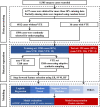Machine Learning to Dynamically Predict In-Hospital Venous Thromboembolism After Inguinal Hernia Surgery: Results From the CHAT-1 Study
- PMID: 37094089
- PMCID: PMC10134160
- DOI: 10.1177/10760296231171082
Machine Learning to Dynamically Predict In-Hospital Venous Thromboembolism After Inguinal Hernia Surgery: Results From the CHAT-1 Study
Abstract
Background: The accuracy of current prediction tools for venous thromboembolism (VTE) events following hernia surgery remains insufficient for individualized patient management strategies. To address this issue, we have developed a machine learning (ML)-based model to dynamically predict in-hospital VTE in Chinese patients after hernia surgery.
Methods: ML models for the prediction of postoperative VTE were trained on a cohort of 11 305 adult patients with hernia from the CHAT-1 trial, which included patients across 58 institutions in China. In data processing, data imputation was conducted using random forest (RF) algorithm, and balanced sampling was done by adaptive synthetic sampling algorithm. Data were split into a training cohort (80%) and internal validation cohort (20%) prior to oversampling. Clinical features available pre-operatively and postoperatively were separately selected using the Sequence Forward Selection algorithm. Nine-candidate ML models were applied to the pre-operative and combined datasets, and their performance was evaluated using various metrics, including area under the receiver operating characteristic curve (AUROC). Model interpretations were generated using importance scores, which were calculated by transforming model features into scaled variables and representing them in radar plots.
Results: The modeling cohort included 2856 patients, divided into 2536 cases for derivation and 320 cases for validation. Eleven pre-operative variables and 15 combined variables were explored as predictors related to in-hospital VTE. Acceptable-performing models for pre-operative data had an AUROC ≥ 0.60, including logistic regression, support vector machine with linear kernel (SVM_Linear), attentive interpretable Tabular learning (TabNet), and RF. For combined data, logistic regression, SVM_Linear, and TabNet had better performance, with an AUROC ≥ 0.65 for each model. Based on these models, 7 pre-operative predictors and 10 combined predictors were depicted in radar plots.
Conclusions: A ML-based approach for the identification of in-hospital VTE events after hernia surgery is feasible. TabNet showed acceptable performance, and might be useful to guide clinical decision making and VTE prevention. Further validated study will strengthen this finding.
Keywords: algorithm; inguinal hernia; logistic regression; machine learning; risk factors; venous thromboembolism.
Conflict of interest statement
The author(s) declared no potential conflicts of interest with respect to the research, authorship, and/or publication of this article.
Figures



Similar articles
-
Prediction Model of in-Hospital Venous Thromboembolism in Chinese Adult Patients after Hernia Surgery: The CHAT Score.Clin Appl Thromb Hemost. 2021 Jan-Dec;27:10760296211051704. doi: 10.1177/10760296211051704. Clin Appl Thromb Hemost. 2021. PMID: 34928746 Free PMC article.
-
Rationale and design of a prospective, multicenter, randomized controlled trial of postoperative venous thromboembolism prophylaxis in Chinese adult patients with inguinal hernia (CHAT-3 trial).Ann Palliat Med. 2021 Oct;10(10):11141-11147. doi: 10.21037/apm-21-1594. Epub 2021 Sep 9. Ann Palliat Med. 2021. PMID: 34498484 Clinical Trial.
-
Development and validation of machine learning models to predict gastrointestinal leak and venous thromboembolism after weight loss surgery: an analysis of the MBSAQIP database.Surg Endosc. 2021 Jan;35(1):182-191. doi: 10.1007/s00464-020-07378-x. Epub 2020 Jan 17. Surg Endosc. 2021. PMID: 31953733 Free PMC article.
-
Sudden death caused by acute pulmonary embolism after laparoscopic total extraperitoneal inguinal hernia repair: a case report and literature review.Hernia. 2017 Jun;21(3):481-486. doi: 10.1007/s10029-017-1587-x. Epub 2017 Feb 7. Hernia. 2017. PMID: 28176033 Review.
-
Machine Learning-Based Predictive Models for Patients with Venous Thromboembolism: A Systematic Review.Thromb Haemost. 2024 Nov;124(11):1040-1052. doi: 10.1055/a-2299-4758. Epub 2024 Apr 4. Thromb Haemost. 2024. PMID: 38574756
Cited by
-
Investigating surgeon performance metrics as key predictors of robotic herniorrhaphy outcomes using iterative machine learning models: retrospective study.BJS Open. 2024 Dec 30;9(1):zrae160. doi: 10.1093/bjsopen/zrae160. BJS Open. 2024. PMID: 39980088 Free PMC article.
-
Machine learning, deep learning and hernia surgery. Are we pushing the limits of abdominal core health? A qualitative systematic review.Hernia. 2024 Aug;28(4):1405-1412. doi: 10.1007/s10029-024-03069-x. Epub 2024 May 18. Hernia. 2024. PMID: 38761300
-
A new simplified risk assessment model enhances postoperative prophylaxis of venous thromboembolism in Chinese adult patients with inguinal hernia (CHAT-3): a prospective, multicenter, randomized controlled trial.Int J Surg. 2024 Sep 1;110(9):5538-5544. doi: 10.1097/JS9.0000000000001758. Int J Surg. 2024. PMID: 38833328 Free PMC article. Clinical Trial.
-
Role of Artificial Intelligence in the Diagnosis and Management of Pulmonary Embolism: A Comprehensive Review.Diagnostics (Basel). 2025 Apr 1;15(7):889. doi: 10.3390/diagnostics15070889. Diagnostics (Basel). 2025. PMID: 40218239 Free PMC article. Review.
-
Risk Factors of In-Hospital Venous Thromboembolism and Prognosis After Emergent Ventral Hernia Repair.Emerg Med Int. 2024 Nov 12;2024:6670898. doi: 10.1155/2024/6670898. eCollection 2024. Emerg Med Int. 2024. PMID: 39564430 Free PMC article.
References
-
- Dhanani NH, Olavarria OA, Holihan JL, et al.Robotic versus laparoscopic ventral hernia repair: one-year results from a prospective, multicenter, blinded randomized controlled trial. Ann Surg. 2021;273(6):1076‐1080. - PubMed
-
- Humes DJ, Abdul-Sultan A, Walker AJ, Ludvigsson JF, West J. Duration and magnitude of postoperative risk of venous thromboembolism after planned inguinal hernia repair in men: a population-based cohort study. Hernia. 2018;22(3):447‐453. - PubMed
-
- Shah DR, Wang H, Bold RJ, et al.Nomograms to predict risk of in-hospital and post-discharge venous thromboembolism after abdominal and thoracic surgery: an American College of Surgeons National Surgical Quality Improvement Program analysis. J Surg Res. 2013;183(1):462‐471. - PubMed
-
- Friedman SM, Uy JD. Venous thromboembolism and postoperative management of anticoagulation. Clin Geriatr Med. 2014;30(2):285‐291. - PubMed
MeSH terms
LinkOut - more resources
Full Text Sources

